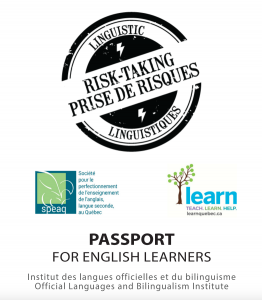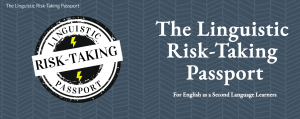The Linguistic Risk-Taking Passport: Take the Risk!
 A C1 project that develops the strategy of risk-taking for Intensive students, and Secondary Cycle 1 students.
A C1 project that develops the strategy of risk-taking for Intensive students, and Secondary Cycle 1 students.
A passport that takes students outside their linguistic comfort zone by taking risks on their own, with their family & friends, with their community, and eventually with the world! Take a risk and continue reading!
We are constantly looking for different ways to present strategies to our second-language learners. We put up posters, plan activities, ask questions, and often remind students to use their strategies to become better learners. The Linguistic Risk-Taking Passport has taken strategy acquisition one big step further. It has taken students out of the classroom, and into high to low linguistic-risk situations, where they are encouraged to take risks in their second language in authentic, real-life settings. Wow!
The passport was originally created by the University of Ottawa’s Linguistic Risk-Taking Initiative to encourage university-level ESL students to take risks, and benefit from extra opportunities to practice their second language outside the classroom. The project succeeded in having students practice their second language more often, and become aware of how important taking risks is to learning.
LEARN and SPEAQ were very excited about the project. They have partnered to adapt this passport for FSL elementary and secondary learners, and ESL Intensive and secondary Cycle 1 students in Quebec. The following is a short summary of what the ESL project is all about.
What is IN the passport?
+ a number of carefully chosen situations (linguistic risks) which the student decides are high, medium or low-risk
+ a place for comments
+ a place to add new risks
+ a self-assessment to be completed before and after the passport is used
How does it work?
1. The teacher uses the Implementation Guide as a resource on how to introduce, sustain and reflect on risk-taking behaviours.
2. The teacher presents each student with a passport that will be used for an allotted period of time.
3. The student circles H (high), M (medium) or L (low) as they complete the risks.
4. The student completes the Self-Assessment and uses the passport experience as a tool for reflection.
Best of all, the student will have…
…found new situations to practice their second language.
…gained insight into the way language is learned.
…gained insight into how risk-taking affects learning in general.
The Linguistic Risk-Taking Passport Website contains…
-an introduction to the project
-a description of the importance of risk-taking in language-learning
-all the documents necessary for using the passport with students
Visit The Linguistic Risk-Taking Passport for more information. We’ve made risk-taking a little less risky for you!
“If we are really wanting to serve our students and help them to develop to become the leaders and learners of today and the future,
taking risks in our practice is not only encouraged, but necessary.”
(George Couros, 2015)
Elizabeth Alloul
LEARN Consultant, ESL Special Project
ealloul@learnquebec.ca


